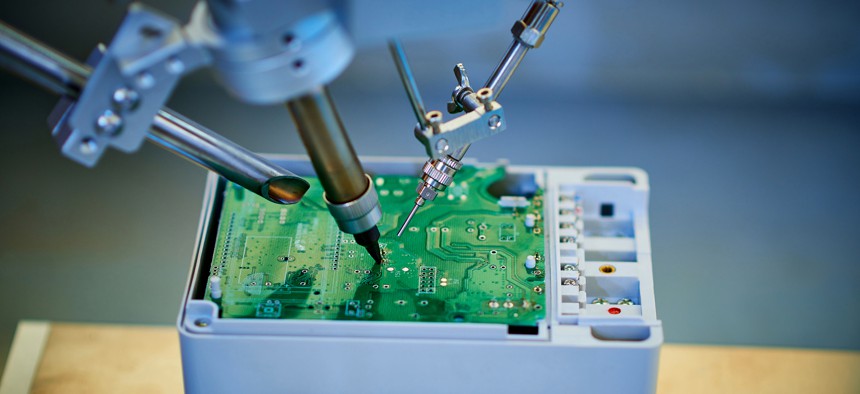CHIPS grants focus on seeding tech ecosystems

Comezora/Getty Images

Connecting state and local government leaders
State and local governments must look beyond semiconductor manufacturing and support investments for infrastructure, workforce and research, a senior Commerce Department official said.
State and local governments looking to take advantage of government funding to bolster chip manufacturing should focus on creating an “ecosystem” far beyond just factories, a senior official at the Department of Commerce said.
Sreenivas Ramaswamy, a senior advisor to the secretary of Commerce, said during a webinar hosted by the National Institute of Standards and Technology that the billions of dollars available in federal subsidies through the CHIPS and Science Act should be paired with local investments in infrastructure, workforce development, research, or through tax incentives for properties.
Ramaswamy, who said the program “will live or die by what happens at the local level,” called on state and local governments to think beyond subsidies to specific companies and focus on bettering whole communities. That echoes a recent NIST strategy paper on CHIPS funding, which outlined the government’s chip manufacturing strategy to “enable and sustain a vibrant domestic industry.”
"This is not a program to just go and build a couple of factories and call it a day,” he said. “It is a program to revitalize the entire domestic semiconductor ecosystem, to improve our national and economic security."
The first Notice of Funding Opportunity for CHIPS grants is expected to be released in February 2023, Ramaswamy said. It comes on the heels of several companies announcing new semiconductor manufacturing plants in the United States.
That includes Intel, which said it would invest more than $20 billion to build two new factories near Columbus, Ohio, and Micron, which announced it would invest $100 billion over the next 20-plus years in a semiconductor manufacturing facility in upstate New York
Intel’s construction and manufacturing effort is the kind of move that Ramaswamy said could result in up to 60 other companies moving in to support that site and deliver “spillover benefits” to the surrounding community.
Also included in the legislation is a provision to spend $10 billion to create 20 “regional technology and innovation hubs,” which must be in areas that are not currently leading centers for technology. A White House fact sheet on the CHIPS and Science Act said the hubs will bring together state and local governments with “institutes of higher education, labor unions, businesses, and community-based organizations to create regional partnerships to develop technology, innovation, and manufacturing sectors.”Local leaders said during the webinar that the effort to disperse technology and innovation hubs more evenly across the country should result in better regional and economic growth and provide more opportunities for residents to take advantage of.
A 2019 Brookings Metro report found that because industries tend to grow in clusters, one-third of the nation’s innovation jobs are found in only 16 of the nation’s 3,006 counties. Will County, Illinois, Board Commissioner Denise Winfrey, who is also president of the National Association of Counties, said that must change.
“Our current approach vastly underutilizes America’s greatest strength: our people,” she said.
Ramaswamy said the federal government has plenty of controls in place to ensure funds go to the right place, adding that while the Commerce Department wants to get grants out as quickly as possible, he warned against a “false sense of urgency.”
"I will caution that this is not a situation like the automotive bailout or a situation like [the Troubled Asset Relief Program],” he said. “By and large, the semiconductor industry is actually in pretty good shape. It is not cash constrained, except for maybe a few small companies, there are exceptions to that. By and large, when you talk about some of these big projects and big companies, you're looking at a situation where there is not an urgency to get cash out the door.”





